Developer Guide
- Acknowledgements
- Setting up, getting started
- Design
- Implementation
- Documentation, logging, testing, configuration, dev-ops
-
Appendix: Requirements
- Product scope
- User stories
- Use cases
- Use case 1: Delete a person
- Use case 2: Add a person
- Use case 3: Tag a person
- Use case 4: Edit a person
- Use case 5: Viewing all persons
- Use case 6: Viewing events
- Use case 7: Finding a person (any field)
- Use case 8: Finding a person (all fields)
- Use case 9: Removing specific tags
- Use case 10: Delete multiple persons
- Use case 11: Adding an event
- Use case 12: Cancelling events
- Non-Functional Requirements
- Glossary
- Appendix: Instructions for manual testing
Acknowledgements
- Referred to CS2103T textbook for fundamental knowledge on software development.
- This product is based on the AddressBook-Level3 project created by SE-EDU initiative
- Libraries used: JavaFx, JUnit5, Jackson
Setting up, getting started
Refer to the guide Setting up and getting started.
Design
.puml files used to create diagrams in this document can be found in the diagrams folder. Refer to the PlantUML Tutorial at se-edu/guides to learn how to create and edit diagrams.
Architecture

The Architecture Diagram given above explains the high-level design of the App.
Given below is a quick overview of main components and how they interact with each other.
Main components of the architecture
Main has two classes called Main and MainApp. It is responsible for,
- At app launch: Initializes the components in the correct sequence, and connects them up with each other.
- At shut down: Shuts down the components and invokes cleanup methods where necessary.
Commons represents a collection of classes used by multiple other components.
The rest of the App consists of four components.
-
UI: The UI of the App. -
Logic: The command executor. -
Model: Holds the data of the App in memory. -
Storage: Reads data from, and writes data to, the hard disk.
How the architecture components interact with each other
The Sequence Diagram below shows how the components interact with each other for the scenario where the user issues the command delete 1.
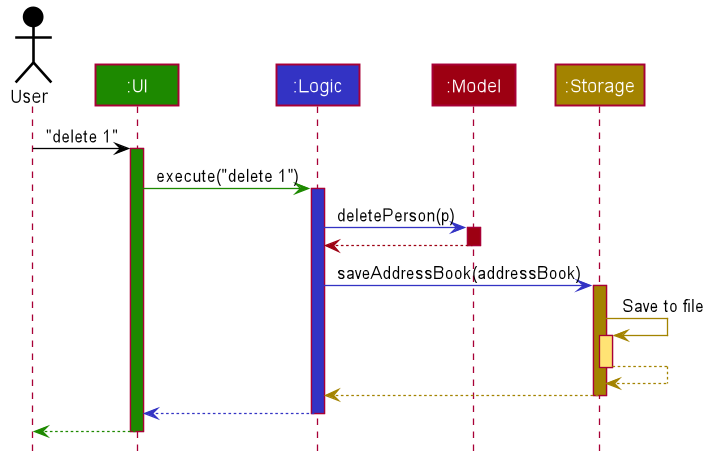
Each of the four main components (also shown in the diagram above),
- defines its API in an
interfacewith the same name as the Component. - implements its functionality using a concrete
{Component Name}Managerclass (which follows the corresponding APIinterfacementioned in the previous point.
For example, the Logic component defines its API in the Logic.java interface and implements its functionality using the LogicManager.java class which follows the Logic interface. Other components interact with a given component through its interface rather than the concrete class (reason: to prevent outside component’s being coupled to the implementation of a component), as illustrated in the (partial) class diagram below.
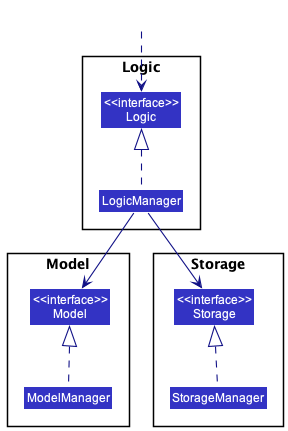
The sections below give more details of each component.
UI component
The API of this component is specified in Ui.java
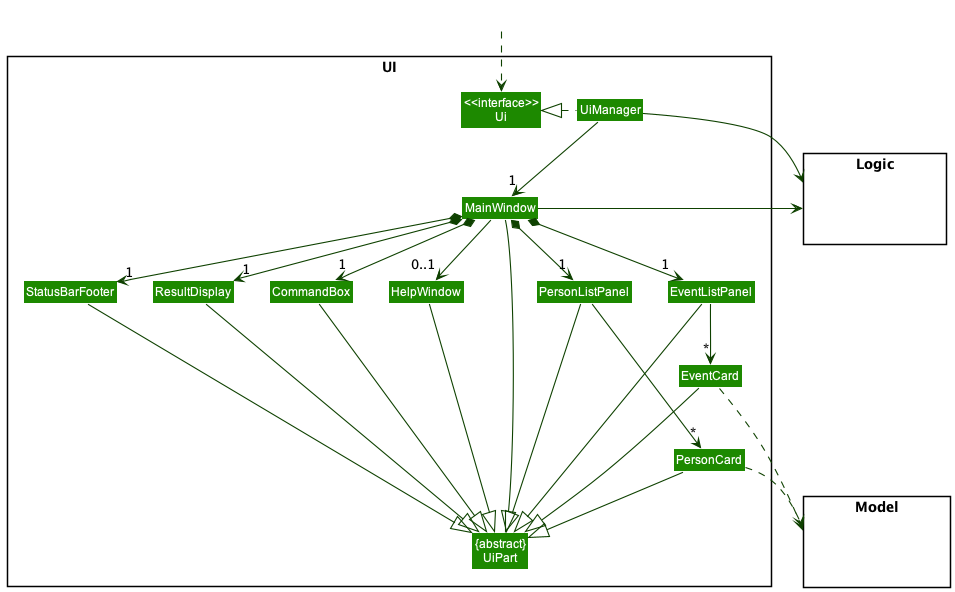
The UI consists of a MainWindow that is made up of parts e.g.CommandBox, ResultDisplay, PersonListPanel, StatusBarFooter etc. All these, including the MainWindow, inherit from the abstract UiPart class which captures the commonalities between classes that represent parts of the visible GUI.
The UI component uses the JavaFx UI framework. The layout of these UI parts are defined in matching .fxml files that are in the src/main/resources/view folder. For example, the layout of the MainWindow is specified in MainWindow.fxml
The UI component,
- executes user commands using the
Logiccomponent. - listens for changes to
Modeldata so that the UI can be updated with the modified data. - keeps a reference to the
Logiccomponent, because theUIrelies on theLogicto execute commands. - depends on some classes in the
Modelcomponent, as it displaysPersonandEventobjects residing in theModel.
Logic component
API : Logic.java
Here’s a (partial) class diagram of the Logic component:

How the Logic component works:
- When
Logicis called upon to execute a command, it uses theAddressBookParserclass to parse the user command. - This results in a
Commandobject (more precisely, an object of one of its subclasses e.g.,AddCommand) which is executed by theLogicManager. - The command can communicate with the
Modelwhen it is executed (e.g. to add a person). - The result of the command execution is encapsulated as a
CommandResultobject which is returned back fromLogic.
The Sequence Diagram below illustrates the interactions within the Logic component for the execute("delete 1") API call.
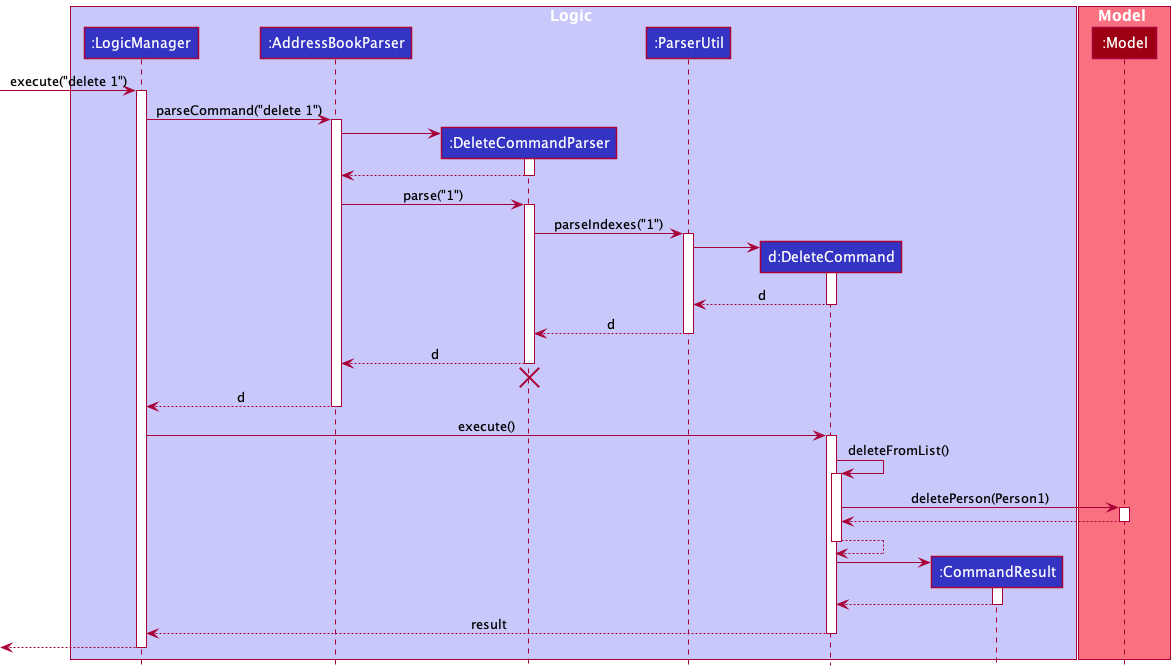
DeleteCommandParser should end at the destroy marker (X) but due to a limitation of PlantUML, the lifeline reaches the end of diagram.
Here are the other classes in Logic (omitted from the class diagram above) that are used for parsing a user command:

How the parsing works:
- When called upon to parse a user command, the
AddressBookParserclass creates anXYZCommandParser(XYZis a placeholder for the specific command name e.g.,AddCommandParser) which uses the other classes shown above to parse the user command and create aXYZCommandobject (e.g.,AddCommand) which theAddressBookParserreturns back as aCommandobject. - All
XYZCommandParserclasses (e.g.,AddCommandParser,DeleteCommandParser, …) inherit from theParserinterface so that they can be treated similarly where possible e.g, during testing.
Model component
API : Model.java
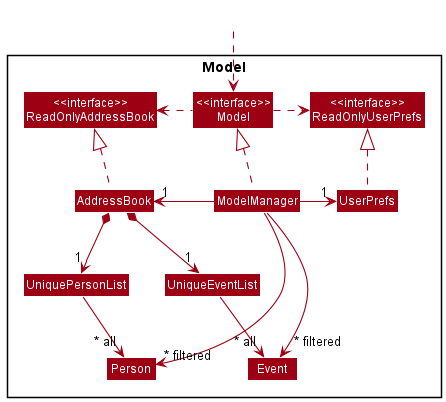
The Model component,
- stores the address book data i.e., all
Personobjects (which are contained in aUniquePersonListobject) and allEventobjects (whihc are contained in aUniqueEventListobject). - stores the currently ‘selected’
Personobjects (e.g., results of a search query) as a separate filtered list which is exposed to outsiders as an unmodifiableObservableList<Person>that can be ‘observed’ e.g. the UI can be bound to this list so that the UI automatically updates when the data in the list change. - stores the currently ‘selected’
Eventobjects (e.g., results of a search query) as a separate filtered list which is exposed to outsiders as an unmodifiableObservableList<Event>that can be ‘observed’ e.g. the UI can be bound to this list so that the UI automatically updates when the data in the list change. - stores a
UserPrefobject that represents the user’s preferences. This is exposed to the outside as aReadOnlyUserPrefobjects. - does not depend on any of the other three components (as the
Modelrepresents data entities of the domain, they should make sense on their own without depending on other components)
Person and Event separately. The Person model has a Tag list in the AddressBook, which Person references. This allows AddressBook to only require one Tag object per unique tag, instead of each Person needing their own Tag objects.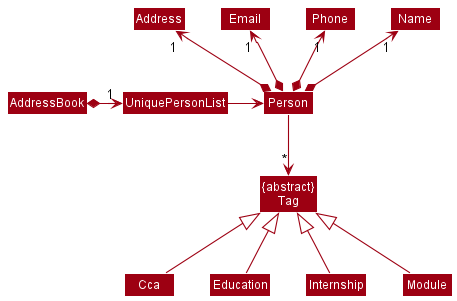

Storage component
API : Storage.java

The Storage component,
- can save both address book data and user preference data in json format, and read them back into corresponding objects.
- inherits from both
AddressBookStorageandUserPrefStorage, which means it can be treated as either one (if only the functionality of only one is needed). - depends on some classes in the
Modelcomponent (because theStoragecomponent’s job is to save/retrieve objects that belong to theModel)
Common classes
Classes used by multiple components are in the seedu.addressbook.commons package.
Implementation
This section describes some noteworthy details on how certain features are implemented.
Delete multiple persons enhancement
Original Implementation
Originally, the idea was to simply call deletePerson on each integer, but this will not work as the indexes of each person
in the contact list might change depending on the order of deletion.
For example:
In a list with only 3 contacts, delete 1 2 3 will not be allowed as there is no longer an index 3 during the 3rd deletion.
Current Implementation
The delete command now has to accept multiple indexes as a valid input. The ParserUtil class can easily facilitate this behaviour by extending the validity checks on the entire string of input.
The workaround is then to delete each person from the largest to the smallest index. The success message displays the details
of those deleted, so in order to show them in the same order as the input, all the details are first extracted out before deletion.
For example:
Similarly, in a list with only 3 contacts, delete 1 2 3 will now be allowed.
Step 1. User enters delete 1 2 3 and LogicManager would execute it.
Step 2. LogicManager would pass the arguments to AddressBookParser to parse the command as a DeleteCommand.
Step 3. The arguments 1 2 3 would be passed into DeleteCommandParser to detect if the deletion is for multiple persons using ParserUtil.
Step 4. Information about Person 1, Person 2 and Person 3 will be extracted according to the last shown list.
Step 5. The deletion process starts sequentially. Person 3 gets deleted followed by Person 2, then Person 1. This ensures correctness in the deletion process.
The Sequence Diagram below illustrates the interactions within the Logic component for the execute("delete 1 2 3") API call.

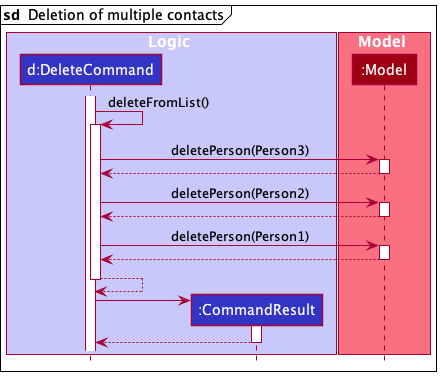
Tag feature
Current Implementation
The current tagging feature is originally a functionality in the Add command. However, it was extracted out and made
into its own command in order to help facilitate a clearer distinction between those features. The Tag command would
allow users to tag additional information to existing persons in the address book.
With this new introduction of the Tag Command, it led to the creation of the abstract class Tag. The idea was to only
allow subclasses of Tag to be tagged to a person. Currently, there are 4 of such subclasses that extends from Tag:
-
Cca- stores information about the person’s cca -
Education- stores information about the person’s degree course -
Module- stores information about the person’s module -
Internship- stores information about the person’s internship

Below is an example usage scenario and how the tagging mechanism behaves at each step:
Step 1. The user enters the following valid TagCommand: tag 1 edu/computer science m/cs2030s m/cs2040s and LogicManager
would execute it.
Step 2. LogicManger would pass the argument to AddressBookParser to parse the command and identify it as a TagCommand.
It will then pass the arguments to TagCommandParser to handle the parsing for the identified TagCommand.
Step 3. TagCommandParser would first parse the index using ParserUtil#parseIndex() to identify the person to tag to.
Afterwards, TagCommandParser would parse the tag arguments provided using ParserUtil#parseTags() to identify the individual
tag types for the arguments provided.
Step 4. After parsing the arguments, the control is handed over to TagCommand where it will return a TagCommand object. It
will eventually return to LogicManager which will call TagCommand#execute() to execute the command.
Step 5. Upon execution, the person will be fetched and tagged using Model#setPerson. The edited person would then be updated
and stored in the addressbook. CommandResult would then generate a success message to inform the user the person has been tagged
successfully.
The following sequence diagram shows how the tag operation works:


Remove Tag feature
Current implementation
The removetag command creates and copies the target Person into a new Person object, except all tags are stored in hashsets instead.
Hashsets allow the application to perform fast searches and checks, such as checking if all provided tags are existing tags in the target Person and to utilize the removeAll() function.
removetag will not allow user to remove a non-existent tag.
Given below is an example scenario of how the removetag command works.
Step 1: User inputs the following valid removetag command: removetag 2 m/cs2107 m/cs2100.
Step 2: The second person on the contact list happens to be David, and he has 4 tags. Below is an object diagram of David during the command execution, before any removal of tags.
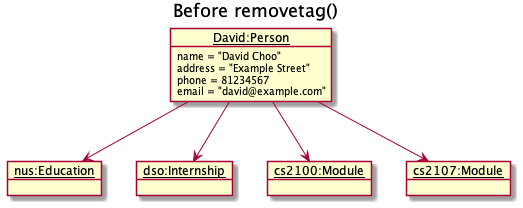
Step 3: After checking that David indeed has the module tags cs2107 and cs2100 given by the command input, the command will execute the removal of tags.
Step 4: The removal of tags is successful, and a success message will be generated.
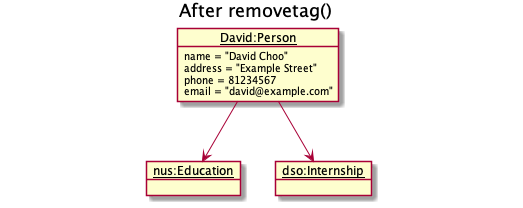
The following sequence diagrams shows how the removetag operation works:


Event feature
Current Implementation
The event command allows the user to create an event which will be stored in the address book. Each Event has the following
fields:
-
EventName- the name of the event -
Information- additional details about the event -
Participants- the persons participating in this event -
DateTime- the date and time of the event
For each Event, the user is able to indicate which of the following persons will be tagged to the event being created. Hence,
Delete and Edit have dependencies on Event where changes in the participants’ names would have to be changed and reflected
accordingly for the respective events that are affected.
Below is an example usage scenario and how the event mechanism behaves at each step:
Step 1. The user enters the valid EventCommand : event 1 name/Lunch Appt info/Having lunch at Hai Di Lao d/2023-02-20 t/12:15 and
LogicManager would execute it.
Step 2. LogicManger would pass the argument to AddressBookParser to parse the command and identify it as an EventCommand.
It will then pass the arguments to EventCommandParser to handle the parsing for the identified EventCommand.
Step 3. EventCommandParser would first parse the index using ParserUtil#parseIndex() to identify the person to tag to the event.
Afterwards, EventCommandParser would parse the event arguments provided using ParserUtil#parseEventName() to identify the event name,
ParserUtil#parseInfo() to identify the event details and ParserUtil#parseDateTime() to identify the event date and time.
Step 4. After parsing the arguments, the control is handed over to EventCommand where it will return an EventCommand object. It
will eventually return to LogicManager which will call EventCommand#execute() to execute the command.
Step 5. Upon execution, the event will be created and added into the AddressBook using Model#addEvent.
CommandResult would then generate a success message to inform the user the event has been added successfully.
The following sequence diagram shows how the tag operation works:


Cancel Event feature
Current Implementation
The cancel event command would allow the user to cancel and remove an event from the address book. The index specified by the user would lead to the deletion of the corresponding event in the event list, as long as it is a valid index. The user also has the option of specifying multiple indexes if multiple deletions are required.
Below is an example usage scenario and how the tagging mechanism behaves at each step:
Step 1. The user enters the valid CancelEventCommand : cancelevent 1 2 and LogicManager would execute it.
Step 2. LogicManger would pass the argument to AddressBookParser to parse the command and identify it as an CancelEventCommand.
It will then pass the arguments to CancelEventCommandParser to handle the parsing for the identified CancelEventCommand.
Step 3. CancelEventCommandParser would first parse the string of indexes using ParserUtil#parseIndexes() to identify the events
and ensure the indexes are unique and positive integers.
Step 4. After parsing the arguments, the control is handed over to CancelEventCommand where it will return a CancelEventCommand object. It
will eventually return to LogicManager which will call CancelEventCommand#execute() to execute the command.
Step 5. Upon execution, the information of the events will be extracted using CancelEventCommand#extractDeletedInfo() that will be use as output for the
notifying the user later. Afterwards, the events will be deleted from the AddressBook using Model#deleteEvent within CancelEventCommand#deleteFromList.
Finally, CommandResult would then generate a success message to inform the user the event has been added successfully.
The following sequence diagram shows how the tag operation works:


Edit Feature
Original Implementation
The edit command uses an EditPersonDescriptor to store the new information that is to be changed in the person. The
EditCommandParser parses the information input and then creates an EditPersonDescriptor where the unchanged fields
are copied over from the existing person and the fields to be overwritten are changed. The Find command then takes in
the descriptor and simply changes the persons attribute values to the values stated in the descriptor.
Current Implementation
We initially built the edit command to allow overwriting of the tag lists. However later we removed that functionality so the command
can only be used to edit the main fields. This is because we realised that it is easier to use the tag and removetag commands to
edit the tag lists instead.
Below is an example usage scenario and how the edit mechanism behaves at each step:
Step 1. The user enters a valid EditCommand : edit 1 n/Alex Ho p/87497763 and LogicManager would execute it.
Step 2. LogicManager would pass the argument to AddressBookParser to parse the command and identify it as a EditCommand.
It will then pass the arguments to the EditCommandParser to handle the parsing for the identified EditCommand.
Step 3. EditCommandParser would first parse the index using ParserUtil#parseIndex() to identify the person to edit.
Afterwards, it would separately parse the arguments according to prefixes using ArgumentTokenizer#Tokerize().
In this case it would use the parsing functions ParserUtil#parseName() and ParserUtil#parsePhone() to parse the name and phone number into
Name and Phone objects.
Step 4. These parsed fields are then stored in a EditPersonDescriptor object, which is then passed into FindCommand.
Control is handed over to FindCommand which will eventually return to LogicManager, which will call FindCommand#Execute() to
execute the command.
Step 5. Upon execution, the person will be fetched and edited using Model#setPerson. The edited person would then be updated
and stored in the addressbook. CommandResult would then generate a success message to inform the user the person has been edited
successfully.
The following sequence diagram shows how the edit operation works:
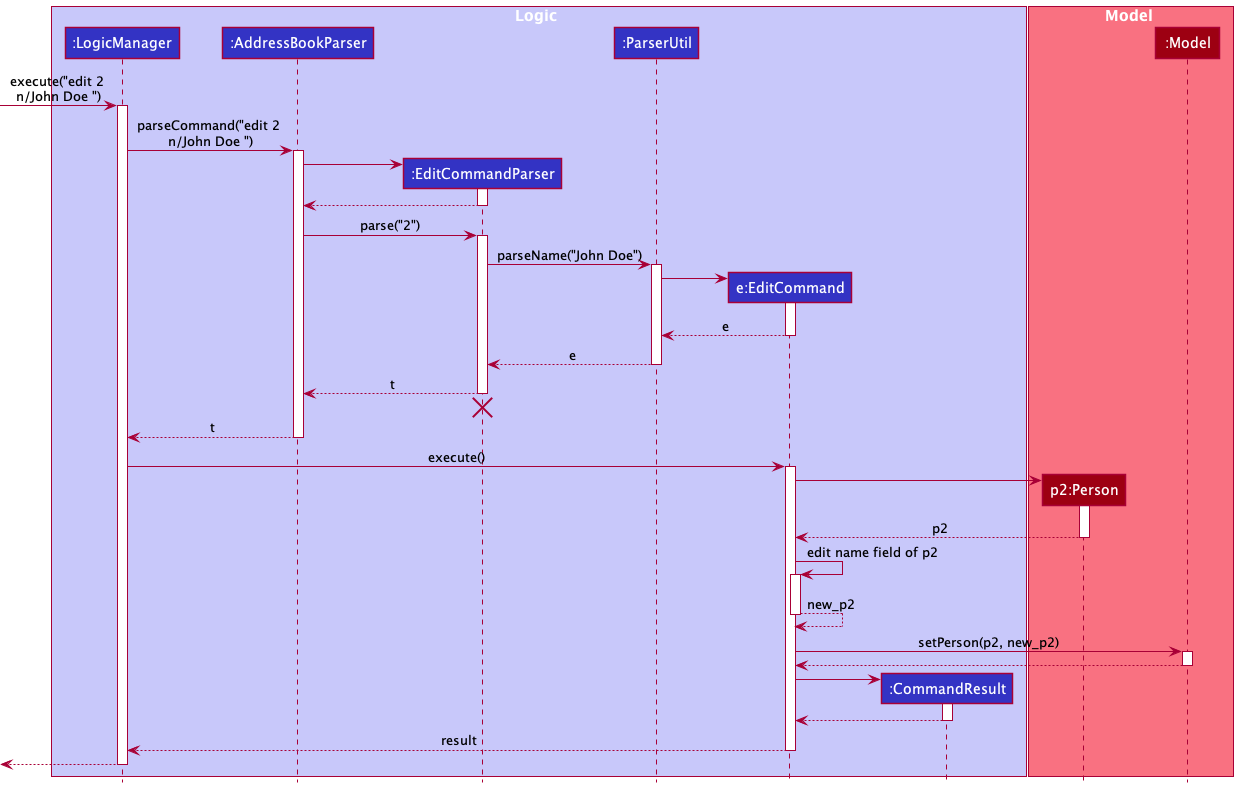
Find feature
Original Implementation
The existing Find feature in AB3 only allowed contacts to be searched for by name. We added additional functionalities
to allow for greater flexibility when filtering large contacts lists according to specific predicates. The Find and
Find -s command now allow the user to search for specific contact details (name, phone number, email and address) or
specific tags.
Current Implementation
The Find command searches for contacts that satisfy any of the given predicates while the Find -s command searches
for contacts that satisfy all the given predicates. Do note that the conjunction and disjunction also applies within
each tag field (see User Guide for more details).
Below is an example scenario of how the finding mechanism behaves at each step:
Step 1. The user enters the valid FindCommand : find n/Alex Yeoh edu/computer science and LogicManager would execute it.
Step 2. LogicManger would pass the argument to AddressBookParser to parse the command and identify it as an FindCommand.
It will then pass the arguments to FindCommandParser to handle the parsing for the identified FindCommand.
Step 3. FindCommandParser would separately parse the arguments according to prefixes. So in this case, it would parse the name
as ‘Alex Yeoh’ and the education tag as ‘computer science’. These would be identified as the fields being searched for. The parsing functions
are in ParserUtil (in this case, ParserUtil#parseNames() and ParserUtil#parseTagsForFind())
Step 4. After parsing the arguments, a FindOrPredicateParser object containing these arguments (in the form of a FindPersonDescriptor object)
is created. FindOrPredicateParser converts the fields searched for into classes that extends Predicate<Person> (such as
NameConatainsKeywordPredicateOr for the name field). It then does the logical ‘OR’ operation on all the predicates
Step 5. Control is then handed over to FindCommand which takes the predicate as a constructor argument. FindCommand#execute()
then calls ModelManager#updateFilteredPersonList() with the predicate as the argument. This changes the filteredList that is
rendered by the UI to only show the contacts for which the predicate evaluates to True. Finally, a CommandResult object with a success
message is returned.
The following class diagram shows important classes for the find command and their relationships. Note that there are similar classes
for find -s and find -e

The find command uses several Predicate classes in its implementation of the feature. The partial class diagram below describes
the relationship between these classes. The predicates for Email and Address follow the same pattern as the ones for Name and Phone.
The predicates for Internship and Education follow the same pattern as those for Cca and Module. They were left out to simplify the diagram.

[Proposed] Undo/redo feature
Proposed Implementation
The proposed undo/redo mechanism is facilitated by VersionedAddressBook. It extends AddressBook with an undo/redo history, stored internally as an addressBookStateList and currentStatePointer. Additionally, it implements the following operations:
-
VersionedAddressBook#commit()— Saves the current address book state in its history. -
VersionedAddressBook#undo()— Restores the previous address book state from its history. -
VersionedAddressBook#redo()— Restores a previously undone address book state from its history.
These operations are exposed in the Model interface as Model#commitAddressBook(), Model#undoAddressBook() and Model#redoAddressBook() respectively.
Given below is an example usage scenario and how the undo/redo mechanism behaves at each step.
Step 1. The user launches the application for the first time. The VersionedAddressBook will be initialized with the initial address book state, and the currentStatePointer pointing to that single address book state.
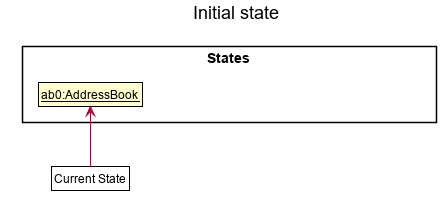
Step 2. The user executes delete 5 command to delete the 5th person in the address book. The delete command calls Model#commitAddressBook(), causing the modified state of the address book after the delete 5 command executes to be saved in the addressBookStateList, and the currentStatePointer is shifted to the newly inserted address book state.
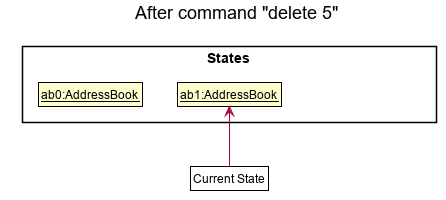
Step 3. The user executes add n/David … to add a new person. The add command also calls Model#commitAddressBook(), causing another modified address book state to be saved into the addressBookStateList.
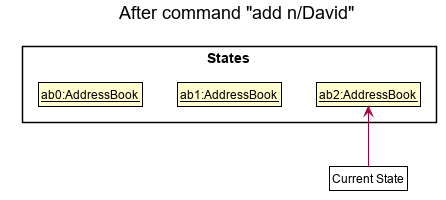
Model#commitAddressBook(), so the address book state will not be saved into the addressBookStateList.
Step 4. The user now decides that adding the person was a mistake, and decides to undo that action by executing the undo command. The undo command will call Model#undoAddressBook(), which will shift the currentStatePointer once to the left, pointing it to the previous address book state, and restores the address book to that state.

currentStatePointer is at index 0, pointing to the initial AddressBook state, then there are no previous AddressBook states to restore. The undo command uses Model#canUndoAddressBook() to check if this is the case. If so, it will return an error to the user rather
than attempting to perform the undo.
The following sequence diagram shows how the undo operation works:
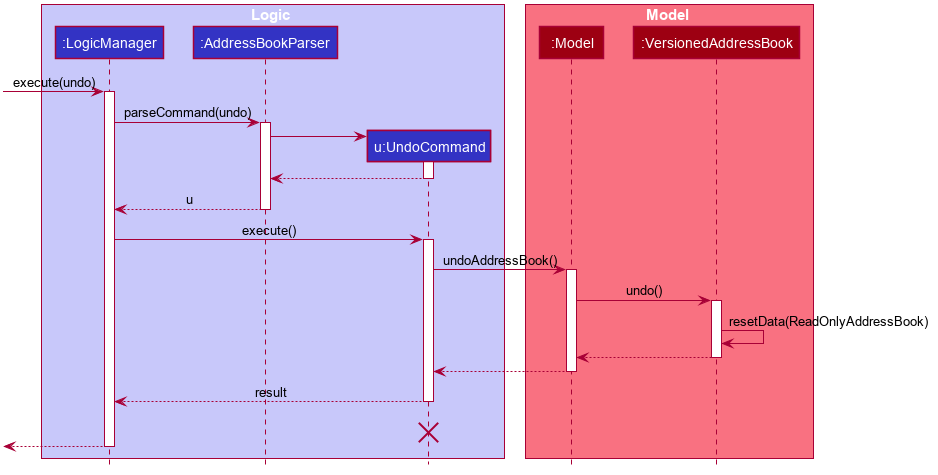
UndoCommand should end at the destroy marker (X) but due to a limitation of PlantUML, the lifeline reaches the end of diagram.
The redo command does the opposite — it calls Model#redoAddressBook(), which shifts the currentStatePointer once to the right, pointing to the previously undone state, and restores the address book to that state.
currentStatePointer is at index addressBookStateList.size() - 1, pointing to the latest address book state, then there are no undone AddressBook states to restore. The redo command uses Model#canRedoAddressBook() to check if this is the case. If so, it will return an error to the user rather than attempting to perform the redo.
Step 5. The user then decides to execute the command list. Commands that do not modify the address book, such as list, will usually not call Model#commitAddressBook(), Model#undoAddressBook() or Model#redoAddressBook(). Thus, the addressBookStateList remains unchanged.
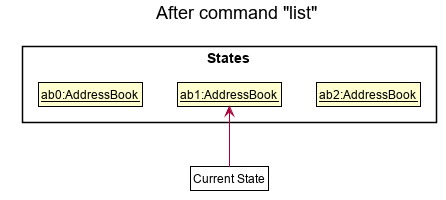
Step 6. The user executes clear, which calls Model#commitAddressBook(). Since the currentStatePointer is not pointing at the end of the addressBookStateList, all address book states after the currentStatePointer will be purged. Reason: It no longer makes sense to redo the add n/David … command. This is the behavior that most modern desktop applications follow.
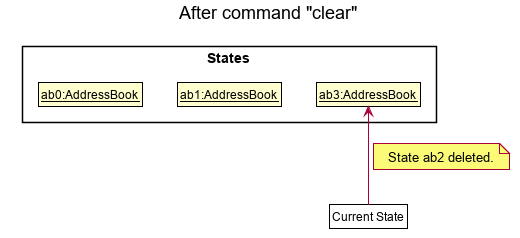
The following activity diagram summarizes what happens when a user executes a new command:

Design considerations:
Aspect: How undo & redo executes:
-
Alternative 1 (current choice): Saves the entire address book.
- Pros: Easy to implement.
- Cons: May have performance issues in terms of memory usage.
-
Alternative 2: Individual command knows how to undo/redo by
itself.
- Pros: Will use less memory (e.g. for
delete, just save the person being deleted). - Cons: We must ensure that the implementation of each individual command are correct.
- Pros: Will use less memory (e.g. for
{more aspects and alternatives to be added}
Documentation, logging, testing, configuration, dev-ops
Appendix: Requirements
Product scope
Target user profile:
- university students who like to maintain a professional contact list
- prefer desktop apps over other types
- can type fast
- prefers typing to mouse interactions
- is reasonably comfortable using CLI apps
Value proposition: to facilitate a convenient way for university students to manage their professional networks with fellow acquaintances
User stories
Priorities:
-
* * *- High (must have) -
* *- Medium (nice to have) -
*- Low (unlikely to have)
| Priority | As a … | I want to … | So that I can… |
|---|---|---|---|
* * * |
new user | see usage instructions | refer to instructions when I forget how to use the App |
* * * |
user | view all of my contacts | |
* * * |
user | add a new contact | |
* * * |
user | delete a contact | remove entries that I no longer need |
* * * |
user | delete multiple contacts at once | delete unwanted entries faster |
* * * |
user | edit an existing contact | update the information when needed |
* * * |
user | tag additional information to an existing contact | keep a memo of such details for future references |
* * |
user | add an event and tag relevant persons in my contact list | keep a memo of such upcoming events with my contacts for future references |
* * |
user | view all of my upcoming events | |
* * |
user | view all of my past events | |
* * |
user | view all of my past and upcoming events | |
* * |
user | cancel an event | |
* * |
user | cancel multiple events at once | cancel unnecessary events faster |
* * |
user | find a person by name | locate details of persons without having to go through the entire list |
* * |
user | find a person by phone number | locate details of persons without having to go through the entire list |
* * |
user | find a person by email address | locate details of persons without having to go through the entire list |
* * |
user | find a person by module | locate details of persons with identical modules, without having to go through the entire list |
* * |
user | find a person by internship | locate details of persons with identical internship, without having to go through the entire list |
* * |
user | find a person by cca | locate details of persons with identical cca, without having to go through the entire list |
* * |
user | find a person by education | locate details of persons with identical education, without having to go through the entire list |
* * |
user with too many irrelevant persons in the contact list | delete all my contacts | reset my contact list |
* |
user that tagged a lot of information to the contacts | remove a specific tag of a contact | avoid going through the trouble of re-tagging all the information again |
* |
user with many persons in the contact list | sort persons by name in alphabetical order | locate a person easily |
Use cases
(For all use cases below, the System is the NUSocials and the Actor is the user, unless specified otherwise)
Use case 1: Delete a person
MSS
1. User requests to list persons.
2. NUSocials shows a list of persons.
3. User requests to delete a specific person in the list.
4. NUSocials deletes the person from its addressbook.
Use case ends.
Extensions
2a. The list is empty.
Use case ends.
3a. The given index is invalid.
- 3a1. NUSocials shows an error message.
Use case resumes at step 2.
Use case 2: Add a person
MSS
1. User adds a new person in the given command format (see User Guide).
2. NUSocials adds the new person to the addressbook.
Use case ends.
Extensions
2a. The given add command is invalid.
- 2a1. NUSocials shows an error message.
Use case resumes at step 1.
Use case 3: Tag a person
MSS
1. User requests to list all persons.
2. NUSocials shows a list of all persons from its addressbook.
3. User inputs command to tag a specific person in the list.
4. NUSocials tags the person.
Use case ends.
Extensions
2a. The list is empty.
Use case ends
3a. The given index is invalid.
- 3a1. NUSocials shows an error message.
Use case resumes at step 2.
3b. The given tag command is invalid.
- 3b1. NUSocials shows an error message.
Use case resumes at step 2.
Use case 4: Edit a person
MSS
1. User requests to list all persons.
2. NUSocials shows a list of all persons from its addressbook.
3. Users requests to overwrite certain fields of the person with updated information.
4. NUSocials edits the person.
Use case ends.
Extensions
2a. The list is empty.
Use case ends.
3a. The given index is invalid.
- 3a1. NUSocials shows an error message.
Use case resumes at step 2.
3b. The given edit command is invalid.
- 3b1. NUSocials shows an error message.
Use case resumes at step 2.
Use case 5: Viewing all persons
MSS
1. User requests to list all persons.
2. NUSocials displays all persons in a list from its addressbook.
Use case ends.
Use case 6: Viewing events
MSS
1. User requests to list all events.
2. NUSocials displays all events in a list from its addressbook.
Use case ends.
Extensions
1a. User specifies past or upcoming events.
Use case resumes at step 2.
2a. NUSocials displays past or upcoming events instead.
Use case ends.
2b. The given find command is invalid.
- 2b1. NUSocials shows an error message.
Use case resumes at step 1.
Use case 7: Finding a person (any field)
MSS
1. User requests to find any person using specific fields.
2. NUSocials shows a list of persons matching any fields from its addressbook.
Use case ends.
Extensions
2a. The given find command is invalid.
- 2a1. NUSocials shows an error message.
Use case resumes at step 1.
Use case 8: Finding a person (all fields)
Similar to Use case 7, except now:
The user wants to find a person that has every field instead.
Use case 9: Removing specific tags
MSS
1. User requests to list all persons.
2. NUSocials shows a list of all persons from its addressbook.
3. User requests to remove certain tags from the person.
4. NUSocials removes the specific tags from the person.
Use case ends.
Extensions
2a. The list is empty.
Use case ends.
3a. The given index is invalid.
- 3a1. NUSocials shows an error message.
Use case resumes at step 2.
3b. The given removetag command is invalid.
- 3b1. NUSocials shows an error message.
Use case resumes at step 2.
3c. The request contains non-existent tags to be removed.
- 3c1. NUSocials shows an error message.
Use case resumes at step 2.
Use case 10: Delete multiple persons
MSS
Similar to Use case 1, except now:
The user wants to delete multiple persons instead.
Extensions
2a. The list is empty.
Use case ends.
3a. One or more of given indexes are invalid.
- 3a1. NUSocials shows an error message.
Use case resumes at step 2.
Use case 11: Adding an event
MSS
1. User adds a new event in the given command format (see User Guide).
2. NUSocials adds the new event to the addressbook.
Use case ends.
Extensions
2a. The given event command is invalid.
- 2a1. NUSocials shows an error message.
Use case resumes at step 1.
Use case 12: Cancelling events
MSS
Similar to Use case 10, except now:
The user wants to delete event(s) instead.
Extensions
2a. The list is empty.
Use case ends.
3a. One or more of given indexes are invalid.
- 3a1. NUSocials shows an error message.
Use case resumes at step 2.
Non-Functional Requirements
- Should work on mainstream OS as long as it has Java
11or above installed. - Should be able to hold up to 1000 persons without a noticeable sluggishness in performance for typical usage.
- A user with above average typing speed for regular English text (i.e not code, not system admin commands) should be able to accomplish most of the tasks faster using commands than using the mouse.
- The system should work on both 32-bit and 64-bit environments.
- The system should respond within 3 seconds.
- The product is strictly an offline application and data is stored locally.
- The product is not required to handle the feature of finding past events based on the date and time. (i.e using a past date & time for the “find -e” command would be invalid)
- The product is not required to handle multiple whitespaces in between words for all data field inputs. (i.e “Alison Baker” will not be identified the same as “Alison Becker”)
- The product is not required to handle the multiple events occurring at the same time. (i.e Multiple events sharing the same date and time would be recognized as separate unique events respectively)
- The product is not required to handle the visibility of long addresses in the person’s contact card.
- The system should be usable by a novice who has used CLI commands before.
Glossary
- Mainstream OS: Windows, macOS
- CLI: Command Line Interface
Appendix: Instructions for manual testing
Given below are instructions to test the app manually.
Launch and shutdown
-
Initial launch
-
Download the jar file and copy into an empty folder
-
Double-click the jar file
Expected: Shows the GUI with a set of sample contacts. The window size may not be optimum.
-
-
Saving window preferences
-
Resize the window to an optimum size. Move the window to a different location. Close the window.
-
Re-launch the app by double-clicking the jar file.
Expected: The most recent window size and location are retained.
-
-
Subsequent launch
-
Make some changes to NUSocials and close the application.
-
Reopen the application by double-clicking the jar file
Expected: Shows the GUI and loads contacts from NUSocials. Should reflect the changes made previously.
-
Deleting person
-
Deleting a person while all persons are being shown
-
Prerequisites: List all persons using the
listcommand. Multiple persons in the list. -
Test case:
delete 1
Expected: First contact is deleted from the list. Details of the deleted contact shown in the status message. -
Test case:
delete 0
Expected: No person is deleted. Error details shown in the status message. Status bar remains the same. -
Other incorrect delete commands to try:
delete,delete x,...(where x is larger than the list size)
Expected: Similar to previous.
-
-
Deleting multiple persons while all persons are being shown
-
Prerequisites: List all persons using the
listcommand. Multiple persons in the list. -
Test case:
delete 1 2 3
Expected: First, second and third contacts are deleted from the list. Details of the deleted contacts shown in the status message. -
Test case:
delete 1 0 2 3,delete 0 1 2 3
Expected: No persons are deleted. Error details shown in the status message. Status bar remains the same. -
Other incorrect delete commands to try:
delete 1 x 2 3,delete 1 2 3 x(where x is larger than the list size)
Expected: Similar to previous.
-
Adding an event
-
Adding an event
-
Test case:
event name/lunch info/at HDL d/2023-11-10 t/12:12
Expected: The new event is added into the event list and displayed on the interface. Details of the added event shown in the status message. -
Test case:
event name/ info/at HDL d/2023-11-10 t/12:12
Expected: No new event is added into the event list. Error details shown in the status message. Status bar remains the same -
Other incorrect event commands to try:
event name/lunch info/ d/2023-11-10 t/12:12,event name/lunch info/at HDL d/2019-11-10 t/12:12,event name/lunch info/at HDL d/2023-11-10 t/28:12
Expected: Similar to previous.
-
Cancelling event
-
Cancelling an event while all events are being shown
-
Prerequisites: List all events using the
showeventscommand. Multiple events in the list. If event list is empty, add new events to the list first. (At least 1 event is added) -
Test case:
cancelevent 1
Expected: First event is deleted from the list. Details of the deleted event shown in the status message. -
Test case:
cancelevent 0
Expected: No event is deleted. Error details shown in the status message. Status bar remains the same. -
Other incorrect cancel event commands to try:
cancelevent,cancelevent x,...(where x is larger than the list size)
Expected: Similar to previous.
-
-
Cancelling multiple events while all events are being shown
-
Prerequisites: List all events using the
showeventscommand. Multiple events in the list. If event list is empty, add new events to the list first. (At least 2 events are added) -
Test case:
cancelevent 1 2
Expected: First and second events are deleted from the list. Details of the deleted events shown in the status message. -
Test case:
cancelevent 1 0 2,cancelevent 0 1 2
Expected: No events are deleted. Error details shown in the status message. Status bar remains the same. -
Other incorrect cancel event commands to try:
cancelevent 1 1 2,cancelevent 1 2 x(where x is larger than the list size)
Expected: Similar to previous.
-
Tagging information to an existing person
-
Tagging cca information to a person
-
Prerequisites: List all persons using the
listcommand. Multiple persons in the list. If person list is empty, add new persons to the list first. (At least 1 person is added) -
Test case:
tag 1 c/boulderingExpected: First person is tagged with the cca information and the information is displayed on the first person’s contact card. Details of the updated tag information of the person is shown in the status message. -
Test case:
tag 1 c/$$Expected: First person is not tagged with the cca information. Error details shown in the status message. Status bar remains the same. -
Other incorrect tag commands to try:
tag 1 c/,tag 1 c/Expected: Similar to previous.
-
- Tagging education information to a person
-
Prerequisites: List all persons using the
listcommand. Multiple persons in the list. If person list is empty, add new persons to the list first. (At least 1 person is added) -
Test case:
tag 1 edu/computer scienceExpected: First person is tagged with the education information and the information is displayed on the first person’s contact card. Details of the updated tag information of the person is shown in the status message. -
Test case:
tag 1 edu/$$Expected: First person is not tagged with the education information. Error details shown in the status message. Status bar remains the same. -
Other incorrect tag commands to try:
tag 1 edu/,tag 1 edu/Expected: Similar to previous.
-
- Tagging internship information to a person
-
Prerequisites: List all persons using the
listcommand. Multiple persons in the list. If person list is empty, add new persons to the list first. (At least 1 person is added) -
Test case:
tag 1 i/shopeeExpected: First person is tagged with the internship information and the information is displayed on the first person’s contact card. Details of the updated tag information of the person is shown in the status message. -
Test case:
tag 1 i/$$Expected: First person is not tagged with the internship information. Error details shown in the status message. Status bar remains the same. -
Other incorrect tag commands to try:
tag 1 i/,tag 1 i/Expected: Similar to previous.
-
- Tagging module information to a person
-
Prerequisites: List all persons using the
listcommand. Multiple persons in the list. If person list is empty, add new persons to the list first. (At least 1 person is added) -
Test case:
tag 1 m/cs2040sExpected: First person is tagged with the module information and the information is displayed on the first person’s contact card. Details of the updated tag information of the person is shown in the status message. -
Test case:
tag 1 m/$$Expected: First person is not tagged with the module information. Error details shown in the status message. Status bar remains the same. -
Other incorrect tag commands to try:
tag 1 m/,tag 1 m/Expected: Similar to previous.
-
Removing tags from an existing person
- Removing tags
-
Prerequisites: List all persons using the
listcommand. Multiple persons in the list. Person selected by the index has to contain tags that are exact matches to the input. -
Test case:
removetag 1 m/cs2040s(First person has a module tag “cs2040s”) Expected: First person’s “cs2040s” module tag removed. Details of the updated tag information of the person is shown in the status message. -
Test case:
removetag 1 m/cs3230(First person does not have a module tag “cs3230”) Expected: No tags removed. Error details shown in the status message. Status bar remains the same. -
Other incorrect
removetagcommands to try:removetag,removetag 1 edu/,removetag x edu/<any value>(where x is larger than the list size) Expected: Similar to previous.
-
Saving data
-
Dealing with missing/corrupted data files
- To simulate a missing or corrupted file, navigate to the
datafolder and deleteaddressbook.jsonor modify some data to be invalid (such as changing an event’s date to 31st February or making someone’s phone number exceed 10 digits). - Open the application, you will be greeted with an empty addressbook.
- To recover, simply edit the
addressbook.jsonagain and reverse the changes made. -
Caution: Deleting the whole
addressbook.jsonfixes the issue as well. However, all previous data will be lost, and a sample addressbook will be loaded.
- To simulate a missing or corrupted file, navigate to the
-
How to save
- NUSocials saves to any changes right away, there is no need for a manual save.